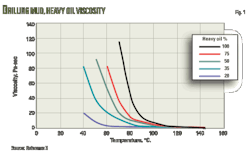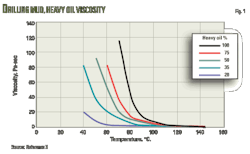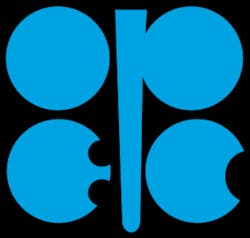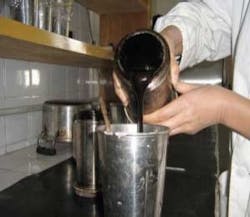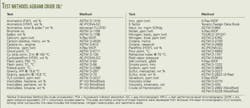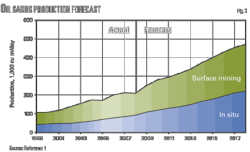Depressant replaces mechanical method for removing blockage
A viscosity depressant proved effective for replacing the time-consuming mechanical methods for removing heavy oil blockages during the drilling of wells in the Tarim basin of China.
The fracture-cavernous Ordovician carbonate reservoir in Lunxi oil field in the Tarim basin is a multilayered structure with well-developed fractures or fissures in each layer, containing a highly viscous crude oil.
Penetrating these naturally fissured formations often encounters two major downhole problems:
1. Drilling mud loss to the fractured formation leads to a decrease of the fluid column height, thus reducing the pressure exerted on the open formations. This results in the resident fluid in the high-pressure zones to flow into the borehole (well kick or blowout), while the loss zone takes in mud.
2. A well kick or blowout triggered by penetrating a high-pressure formation can in turn cause mud loss to lower pressure formations due to a high shut-in pressure (SIP) or heavy kill mud.
When mud loss occurs, injection of lost circulation material, if not done in time, triggers a well kick that leads to heavy oil flowing into the annulus. This increases the annular pressure and aggravates mud loss.
Mud loss allows more heavy oil into the annulus. When this oil moves up in the annulus, its temperature decreases and its viscosity increases (Figs. 1-3).
Once the heavy-oil temperature decreases to below its congealing point, the solidified crude oil nearly blocks the annulus, causing the drilling mud not to circulate properly and leading to stuck drill pipe.
Analysis shows that in Lunxi oil field, mud loss, well kicks, and stuck drilling tools occurred 14 times in 18 oil wells during 1997-2005, with a drilling time loss of 873 hr.
These problems delayed drilling operation, and the mud loss and heavy oil influx caused serious formation damage.
Drilling wells in this field thus required an effective blockage-removal technique. One solution was to develop an additive that can emulsify crude oil and effectively remove the blockage.
Well history
The drilling of Well LG13 provides an example of the way blockages occur in the field.
The well at 17:47 on Mar. 5, 2002, encountered lost circulation at a rate of 8.1 cu m/hr. The depth was 5,919.77 m and mud density was 1.08 g/cc.
At 19:25, the drilling bit reached 5,923.34 m, and the rate of mud loss rose to 33.0 cu/hr. At 19:57, the drilling operation stopped, and the well kicked at a rate of 16.9 cu m/hr.
The drilling operation continued until 22:00, and heavy crude oil flow at the wellhead was 0.7 cu m/hr. Subsequently the drillstring stuck.
The drilling crew rotated the pipe to unfreeze the sticking and continued drilling until no mud circulation returned to the surface at 23:30. The standpipe pressure (SSP) with the blocked annulus was 17 MPa.
Analysis indicated that the formation between 5.919-5923.5 m is a fracture-cavernous heavy-oil zone with a 1.16 formation pressure coefficient that had an estimated oil influx rate of 14 l./sec.
Mechanical analysis
One can approximate the annulus pressure loss of the mixed drilling mud and heavy oil with the equation shown in the equation box.1
The terms in the equation are:
• Δpmoa—annulus pressure loss of mixed drilling mud and heavy oil.
• ρd—drilling mud density.
• Q—drilling mud flow rate.
• q—heavy-oil flow rate into wellbore, which one can estimate with a radial fluid flow model.2
• µmo—mixed drilling mud and heavy oil viscosity.
• T—mixed liquid or drilling mud temperature, also referred to as the wellbore temperature (Fig. 2). Fig. 1 plots the temperature dependence of µmo for different mixtures with difference amounts of heavy oil.
• µpv—drilling mud viscosity.
• dh—borehole diameter.
• dp—drilling column OD.
Heavy crude takes up the annulus space from depth H to l, while the drilling mud and heavy crude mixture occupies the space from depth l to surface.
After heavy oil flows into the borehole and mixes with the drilling mud, the annulus pressure loss increases and the flow rate of the mixture in the annulus decreases because of the increased viscosity of the mixture as it moves up in the annulus.
At a certain depth, the mixture stops moving up when the temperature reaches the crude oil congealing point, resulting in the blocked annulus.
One can obtain the annulus blocking time t with an iteration scheme and a comparison of the total borehole flowing friction (Δpmoa + flowing friction of drilling mud in the borehole) and the standpipe pressure (SSP), ps.
To remove the heavy-oil blockage, one needs to apply a blockage-relieving pressure, which equals to the minimum annulus friction for actuating circulation.
Blockage relieving pressure
As Fig. 4 shows,3 3.4 hr after the heavy oil first reached surface, the minimum annulus friction that the circulation needs to overcome is 14.55 MPa, and the circulation friction of the drilling mud in the drilling string is 2.56 MPa, computed using the empirical equation in the equation box.
Thus, the total borehole flowing friction (annulus flowing friction + flowing friction of drilling mud in the borehole) is 17.11 MPa, which is greater than the SSP of 17 MPa. Hence, the annulus was blocked and drill pipe stuck.
As time proceeds, the minimum annulus flowing friction that circulation needs to overcome increases; and therefore, restoring circulation requires a greater blockage relieving pressure.
As time increases beyond 9 hr, however, this minimum annulus flowing friction varies very slowly and remains nearly constant.
Based on Fig. 4, the reverse circulation blockage relieving pressure is 25 MPa.
After the well was shut-in, the drilling crew reverse circulated the drilling mud and pumped drilling mud into the annulus to relieve the heavy oil blockage. The drilling mud density was 1.10 g/cc, and the pump pressure was 25 MPa.
The reverse circulation removed the blockage. After removing the blockage, the crew pumped another 80 cu m of drilling mud into the annulus to squeeze the heavy oil back into the fractured formation.
After the drilling operation returned to normal, the crew raised the drilling mud density to 1.15 g/cc. Mud losses, however, continued while drilling deeper.
Because of this, it was decided to formulate a crude oil emulsifying additive for removing blockages.
Drilling mud design
The usual drilling mud system used in Lunxi heavy-oil formations is sulfonated polymer mud with 4% oil + 0.4% NaOH + 0.2% CMC-LV + 5% SMP-1 + 4% SPNH + 2.0% MHR-86D + 11% pulverized lime.
In the formula, NaOH is sodium hydroxide, CMC-LV is low-viscosity sodium carboxymethylcellulose, SMP-1 is sulfomethylated phenolic resin, SPNH is sulfolignite resin, and MHR-86D is a lubricant.
The properties of the drilling mud comply with API standards (Table 1).
The mud has an API filtration loss after hot rolling at 130° C. of 2.6 ml, friction coefficient of the mud cake of 0.07, and rheological properties within the API standard.
Viscosity depressant selection
In selecting a viscosity depressant, the testing used sulfonated polymer mud as a base mud, and modified muds with three different viscosity depressants: CVR, SP-80, and Tween-80.
CVR is a viscosity reducing emulsifier produced by a Xing Jiang-based Chinese company, SP-80 is a sorbitan monooleate, and Tween-80 is a polyoxyethylene sorbitan monooleate.
Fig. 5 plots the apparent viscosity of the mixture of sulfonated polymer mud with 30% heavy oil vs. the viscosity depressant concentration. The figure shows that the viscosity of the mixture decreases initially with an increase in the concentration of the viscosity depressant.
When the concentration of Tween-80 is 0.6%, the apparent viscosity of the mixture reaches a minimum value 70 mP-sec but increases as the concentration increases.
For the SP-80, the apparent viscosity of the mixture reaches a minimum 70 mP-sec at 0.3% concentration and starts to oscillate with an increase in the concentration more than 0.3%.
For the CVR additive, after hot rolling and subsequent cooling of the mixture to normal temperature, the heavy oil in the mixture became diluted and the base mud and heavy oil dissolve each other when the concentration of CVR rose to 0.6% from 0.15%.
The apparent viscosity of the mixture drops to 54.5 mP-sec, which is the lowest among the three additives.
The photos show the flowability of the drilling mud mixture that includes the additive CVR and crude oil. The left photo is without hot rolling and the right photo is after hot rolling and cooling (Fig 6). |
Fig. 6 illustrates the flowability of the hot-rolled mixture and a mixture without hot rolling.
When the concentration of CVR is greater than 0.6%, the apparent viscosity of hot-rolled mixture does not change with CVR concentration and remains at 54.5 mP-sec (Fig. 5). Furthermore, increased CVR concentration has no effect on the properties and performance of the mud (Table 2).
The tests, thus concluded that for a mixture of sulfonated polymer mud and 30% heavy oil, 0.6% CVR in the mixture is the optimal choice for reducing apparent viscosity.
Similar experiments showed the effects with various heavy-oil concentrations. Based on these experiments, the optimum formula for the blockage-relieving mud system is 4% oil + 0.4% NaOH + 0.2% CMC-LV + 5% SMP-1 + 4% SPNH + 2.0% MHR-86D + 11% pulverized lime + X% CVR.
The CVR additive percentage X varies with crude oil mass fraction in the mixture, as plotted in Fig. 7.
Field applications
Based on the testing, the recommendation was to add 0.6% CVR to the drilling mud to emulsify the potential mixed liquid in the annulus.
With the recommended drilling mud with the viscosity depressant, two wells, AA45, AA701, were drilled through the Ordovician reservoir beds without problems.
The two wells had boreholes nearly in gauge and experience no drilling pipe sticking induced by heavy oil blockage.
Unproductive time during the drilling was less than 10% (Tables 3 and 4).
Well Lungu 701 was drilled in 64.79 days, 15.21 days ahead of schedule, with a productive time of 93.43%.
The unproductive time of Lungu 45 was 9.78%.
Acknowledgments
This work was supported by the program for new century excellent talents in universities, the Ministry of Education of China, and by the Tarim Oilfield Co. of CNPC.
References
1. Chen, D., and Guan, Z., Drilling Engineering Theory and Technology, Shandong: China University of Petroleum Press, 2006.
2. Lubinski, A., Developments in Petroleum Engineering, Vol. 2. Houston: Gulf Publishing Co., 1981.
3. Drilling Proposal: Analysis and Risk-assessment in Heavy Oil Formations. Internal Report, Tarim Oilfield Co. of CNPC, 2007.
The authors
Correction
Two curves in Fig. 2 in the article "GAS SHALE—2: Lessons learned help optimize development" by Vello Kuuskraa and Scott Stevens (OGJ, Oct. 5, 2009, p. 53) had incorrect labels. The corrected figure is:
